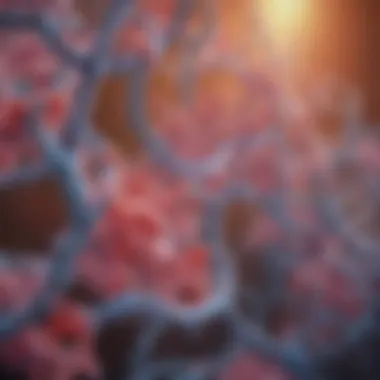Understanding Alpha-1 Antitrypsin Deficiency Causes


Intro
Alpha-1 antitrypsin deficiency is more than just a medical term; it is a significant health condition that influences many lives. Understanding its causes is essential for better management and treatment. This deficiency occurs due to a lack of a specific protein that protects vital organs, notably the lungs and liver. With a complex interplay of genetic, environmental, and lifestyle factors, the quest for knowledge is paramount.
This article aims to dissect these causes and offer clarity on how they shape health outcomes. Diving deep, we will explore genetic predispositions, effects of environment, and how personal choices can compound risks. By scrutinizing each factor closely, we can gain insights into ways to control and potentially mitigate the impacts of this condition.
Research Overview
Summary of Key Findings
Research showcases that the primary cause of alpha-1 antitrypsin deficiency is genetic mutations in the SERPINA1 gene. These mutations lead to insufficient production of the protein. The most common form is the Z allele. People who inherit two Z alleles often face a higher risk of developing related health issues. Additionally, research also highlights environmental factors like smoking, pollution, and occupational hazards as exacerbating elements.
Methodologies Employed
Studies have utilized various methodologies to explore alpha-1 antitrypsin deficiency. Genetic sequencing has allowed researchers to identify specific mutations within the SERPINA1 gene. Population studies and surveys have offered insights into environmental influences, linking them to health outcomes in affected groups. Clinical trials also examine how certain lifestyle choices can lead to variability in conditions among individuals.
In-Depth Analysis
Detailed Examination of Results
The findings reveal a direct correlation between genetic makeup and the severity of the deficiency. Individuals with one normal allele and one Z allele may show mild symptoms or none, while those with two Z alleles usually experience severe health complications. Furthermore, the studies indicate that the presence of environmental stressors can highlight these genetic predispositions.
"Genetic factors set the stage, but environmental elements can significantly affect health outcomes."
Lifestyle choices play a dual role as well. For instance, smoking can lead to an accelerated decline in lung function for those with this deficiency. Obesity can worsen liver function in patients already limited by hereditary factors. This interaction between inherited traits and external influences constitutes the basis for personalized medicine in treating alpha-1 antitrypsin deficiency.
Comparison with Previous Studies
Previous studies have emphasized the genetic roots but often understated the environmental contributors. Recent research has shifted focus to include the lifestyle aspects more prominently. This evolution in understanding reflects a growing recognition of the multifaceted nature of the deficiency. Data gathered from large population studies, highlighting interactions between genes and environment, suggest a layered approach to treatment may provide more effective management strategies.
In summary, a comprehensive grasp of the causes behind alpha-1 antitrypsin deficiency unveils a pathway toward enhanced health outcomes. Understanding genetic influences, combined with awareness of environmental and lifestyle factors, is crucial in addressing this condition.
Prologue
Alpha-1 antitrypsin deficiency is not merely a clinical term; its implications reach into the heart of respiratory and liver health. This genetic condition compromises the production of a vital protein, posing significant risks to individuals affected by it. By unpacking this topic, we aim to elucidate the underlying causes, examining genetic, environmental, and lifestyle factors that contribute to its development. Understanding Alpha-1 antitrypsin deficiency is essential for healthcare professionals, researchers, and educators. It helps in developing effective screening methods, informing treatment plans, and promoting awareness among at-risk populations.
Definition of Alpha-1 Antitrypsin Deficiency
Alpha-1 antitrypsin deficiency is a genetic disorder characterized by reduced levels of the protein known as alpha-1 antitrypsin (AAT). This protein is primarily produced in the liver and plays a crucial role in protecting the lungs and other tissues from damage. When AAT levels are deficient or dysfunctional, individuals may experience progressive lung disease, liver disorders, or other complications. The condition can range from asymptomatic cases to severe manifestations requiring medical intervention.
Understanding the definition provides a foundation for exploring its genetic basis and clinical features.
Importance of Alpha-1 Antitrypsin
The significance of alpha-1 antitrypsin cannot be overstated. AAT serves as a protective agent against various proteolytic enzymes, especially neutrophil elastase, which can damage alveolar tissue in the lungs. This protective role is critical for maintaining respiratory health.
A deficiency in this protein can lead to conditions such as emphysema, chronic obstructive pulmonary disease (COPD), and liver cirrhosis. Therefore, recognizing the importance of AAT is vital in understanding the health implications of its deficiency and driving efforts towards preventative and therapeutic measures.
"An understanding of alpha-1 antitrypsin and its functions provides key insights into managing associated health conditions."
In summary, this introduction sets the stage for a detailed exploration of alpha-1 antitrypsin deficiency, revealing the layers of complexity surrounding its causes, effects, and potential interventions.
Genetic Causes
The genetic basis of Alpha-1 Antitrypsin Deficiency is crucial to understanding this condition. Genetic causes play a significant role in determining an individual's susceptibility to this disorder. Knowledge of the genetic framework allows researchers and healthcare professionals to identify at-risk individuals. Furthermore, it aids in developing targeted interventions and therapies. Ultimately, enhancing awareness of genetic influences can improve healthcare outcomes for those affected.
Inheritance Patterns


Alpha-1 Antitrypsin Deficiency follows an autosomal co-dominant inheritance pattern. This means that an individual can inherit both normal and defective alleles from their parents. If one parent passes down a defective gene and the other a normal one, the individual may still produce some functional protein, albeit at reduced levels. The severity of the condition often correlates with the combination of alleles inherited.
- Individuals can be classified into several phenotypes based on the severity of deficiency.
- The most common phenotype associated with severe deficiency is the Z phenotype, where two defective alleles are inherited.
- Other phenotypes such as S or normal alleles also exist and influence the clinical presentation.
Understanding these patterns is fundamental for genetic counseling and managing family planning for individuals with Alpha-1 Antitrypsin Deficiency.
Mutations in the SERPINA1 Gene
The SERPINA1 gene, located on chromosome 14, is responsible for producing alpha-1 antitrypsin, a protein that protects the lungs and liver from damage. Mutations in this gene lead to impaired protein production and secretion. The two primary mutations that cause deficiency are:
- Z allele: This mutation results in the accumulation of the protein in the liver, leading to liver damage.
- S allele: This variant produces less functional protein than the normal allele but more than the Z variant.
More than 100 mutations have been identified in the SERPINA1 gene. Each mutation varies in its impact on protein function, influencing the clinical manifestation of the disease. Genetic testing can identify these mutations, which is essential for validating the diagnosis and guiding treatment decisions.
Pathways of Genetic Expression
Genetic expression of the SERPINA1 gene involves several biochemical pathways that regulate the production and processing of alpha-1 antitrypsin. Factors such as transcription factors and enhancers influence the gene's expression levels. In normal circumstances, the protein is synthesized in the liver and secreted into the bloodstream. However, in individuals with mutations, the pathways are disrupted and lead to insufficient protein levels.
- The unfolded protein response (UPR) is often triggered due to the accumulation of improperly folded proteins, resulting in liver stress and potential liver disease.
- Various environmental factors and lifestyle choices can exacerbate the effects of these genetic mutations, highlighting the interaction between genetics and external influences in the disease progression.
Understanding the genetic pathways contributes to a more comprehensive view of how Alpha-1 Antitrypsin Deficiency develops and can lead to targeted therapies aimed at restoring proper protein expression or function.
"Knowledge of genetic causes is vital for effective management and treatment of Alpha-1 Antitrypsin Deficiency."
Environmental Factors
Understanding the role of environmental factors in alpha-1 antitrypsin deficiency (AATD) is essential for a comprehensive view of its causes. While genetic factors play a significant role in this condition, external influences cannot be overlooked. Environmental elements interact with genetic predispositions, potentially exacerbating health issues related to AATD. This section aims to explore how certain environmental factors impact the severity of symptoms and overall health outcomes for individuals affected by this deficiency.
Impact of Smoking
Smoking is a critical environmental factor that has a significant negative influence on individuals with alpha-1 antitrypsin deficiency. Nicotine and other harmful substances in cigarettes can lead to lung damage and worsen the existing emphysema associated with AATD. Those with the deficiency already have reduced protection against enzymatic damage to lung tissues, and smoking exacerbates this vulnerability.
- Consequences of Smoking in AATD:
- Increased risk of lung infections
- Accelerated decline in lung function
- Greater likelihood of developing COPD (Chronic Obstructive Pulmonary Disease)
For individuals with AATD, cessation of smoking is one of the most effective ways to improve respiratory health. Studies demonstrate that even brief periods of smoking cessation can lead to improvements in lung function.
Occupational Exposures
Certain occupational environments expose individuals to toxins that influence respiratory health negatively. Jobs involving exposure to dust, chemicals, or fumes can be particularly harmful for those with AATD. Workers in industries like construction, manufacturing, or even healthcare may face increased risk.
- Types of harmful exposures include:
- Chemical solvents
- Asbestos
- Coal dust and other particulate matter
It is essential for those with alpha-1 antitrypsin deficiency to recognize their working environment's impact on their health and take preventive measures to reduce exposure. Employers need to implement adequate safety measures to protect their employees from harmful exposures, particularly those with pre-existing health conditions.
Air Pollution and Respiratory Health
Air quality significantly influences respiratory health for everyone, but those with alpha-1 antitrypsin deficiency may experience heightened effects. Pollutants such as smog, particulate matter, and even indoor air contaminants can aggravate symptoms, leading to serious health complications. Studies indicate that long-term exposure to air pollution correlates with increased respiratory symptoms and decreased lung function in sensitive populations.
"Air pollution is a complex mixture of substances that can vary widely in composition and concentration, depending on the source and environment."


Living in urban areas with high pollution levels poses additional risks for those with AATD. Measures such as using air purifiers indoors, avoiding outdoor activities on high pollution days, and supporting initiatives that improve air quality can be beneficial for their health.
In summary, the intersection of environmental factors with alpha-1 antitrypsin deficiency is complex. Recognizing the impact of smoking, occupational exposures, and air pollution can lead to better management strategies for those affected. Awareness and lifestyle modifications are key to improving health outcomes for individuals with this condition.
Lifestyle Factors
Lifestyle factors play a significant role in the overall health of individuals with Alpha-1 Antitrypsin Deficiency. These factors can influence the onset and progression of symptoms associated with this condition. By understanding how daily choices impact health, individuals can take steps to manage their risks more effectively. Here, we will explore three vital components: nutrition, physical activity, and alcohol consumption.
Nutrition and Its Role
Nutrition is fundamental for everyone, but it holds special relevance for those with Alpha-1 Antitrypsin Deficiency. A balanced diet helps maintain lung and liver health, which are primarily affected by this condition. Specific nutrients can enhance the body's ability to fight inflammation and oxidative stress. Such nutrients include:
- Antioxidants: Found in fruits and vegetables, antioxidants fight free radicals which may worsen lung damage.
- Omega-3 fatty acids: These acids, present in fish and flaxseeds, may reduce inflammation in the respiratory system.
- Proteins: Vital for overall body function, adequate protein intake supports the synthesis of proteins like Alpha-1 Antitrypsin itself.
Incorporating a variety of whole foods into the diet can help build a strong biological foundation. Conversely, processed foods, high in sugars and unhealthy fats, can lead to increased inflammation, complicating health for those with this deficiency. Evaluating one's dietary habits regularly is crucial.
Physical Activity and Respiratory Health
Regular physical activity is a key determinant of respiratory health. Exercise increases lung capacity and efficiency by promoting better circulation and oxygen delivery throughout the body. For individuals with Alpha-1 Antitrypsin Deficiency, engaging in moderate activities, such as walking, swimming, or cycling, can be especially beneficial.
Some specific benefits include:
- Improved lung function: Exercise can lead to better respiratory muscle strength, easing breathing and enhancing endurance.
- Weight management: Maintaining a healthy weight reduces the strain on lungs and supports overall health.
- Mental health benefits: Physical activity can also alleviate symptoms of anxiety and depression, which may arise from chronic health concerns.
Crafting a routine that incorporates aerobic exercises, strength training, and flexibility movements can yield significant improvements in health outcomes.
Alcohol Consumption Effects
Alcohol consumption presents another lifestyle consideration regarding Alpha-1 Antitrypsin Deficiency. The liver, which is critically impacted by this deficiency, faces additional strain when alcohol is consumed. Even moderate drinking can exacerbate damage to liver function. Some critical points include:
- Increased risk of liver disease: Excessive alcohol can lead to liver cirrhosis, which poses serious health threats.
- Potential interactions with medications: Alcohol can interfere with therapies prescribed for managing symptoms of Alpha-1 Antitrypsin Deficiency, diminishing their effectiveness.
In light of these factors, it is advisable for individuals with this condition to limit or avoid alcohol entirely. Monitoring consumption closely is vital for protecting liver health.
Managing lifestyle factors such as nutrition, exercise, and alcohol intake can have a profound impact on the health of those living with Alpha-1 Antitrypsin Deficiency. Taking proactive steps in these areas can lead to significant enhancements in overall well-being.
Understanding the interplay between lifestyle choices and health outcomes is crucial, offering individuals the knowledge to take charge of their health.
Clinical Implications
Understanding the clinical implications of Alpha-1 Antitrypsin Deficiency (AAT deficiency) is crucial for several reasons. This genetic condition can significantly impact an individual's health, particularly concerning lung and liver function. Recognizing symptoms early allows for timely interventions, reducing long-term complications. Furthermore, raising awareness about this condition among healthcare professionals improves diagnosis rates and management strategies.
Symptoms of Alpha-1 Antitrypsin Deficiency
The symptoms of AAT deficiency can vary widely among individuals. Some may experience mild issues, while others face severe health challenges. Common symptoms include:
- Shortness of breath: Often emerging during physical activity or even at rest.
- Chronic cough: Persistent coughing can lead to frequent respiratory infections.
- Fatigue: A general sense of tiredness is common, affecting daily activities.
- Liver-related symptoms: This could include jaundice (yellowing of the skin), dark urine, and swelling in the abdomen.
These indicators are often misattributed to other conditions, which complicates diagnosis. Early recognition plays a substantial role in management.
Diagnosis and Screening Methods
Diagnosing AAT deficiency involves a combination of clinical assessments and laboratory tests. Key methods include:


- Blood test: This measures the level of alpha-1 antitrypsin in the blood. Low levels can indicate deficiency.
- Genetic testing: Identifies specific mutations in the SERPINA1 gene associated with AAT deficiency.
- Liver biopsy: In more severe cases, a biopsy may help assess liver damage due to AAT deficiency.
These methods can confirm the diagnosis, allowing healthcare providers to develop appropriate treatment plans for affected individuals.
Treatment Options Available
While there is currently no cure for AAT deficiency, several treatment options can help manage the condition and its symptoms. These include:
- Augmentation therapy: This involves intravenous infusions of healthy AAT protein to help restore levels in the body.
- Bronchodilators: Used to relieve breathing difficulties by relaxing bronchial muscles.
- Liver transplantation: For individuals with severe liver disease, transplanting a healthy liver can be life-saving.
- Lifestyle modifications: Smoking cessation and maintaining a healthy diet can improve overall well-being.
The combination of these treatment strategies can significantly enhance quality of life for individuals with AAT deficiency, underscoring the importance of a tailored approach in clinical settings.
Overall, understanding the clinical implications of Alpha-1 Antitrypsin Deficiency is vital for implementing effective strategies aimed at improving patient outcomes.
Research and Future Directions
Research and Future Directions in the context of Alpha-1 Antitrypsin Deficiency (AAT deficiency) is critical. Advances in genetic understanding, treatment options, and patient management are essential for addressing this condition effectively. Understanding the nuances of AAT deficiency can lead to improved outcomes and quality of life for affected individuals.
Current Research Trends
Current research trends are focusing on a variety of aspects of AAT deficiency. Scientists are exploring the genetics surrounding the SERPINA1 gene that encodes Alpha-1 Antitrypsin. Large genome-wide association studies are uncovering mutations and their impact on protein production. Moreover, researchers are investigating how environmental factors may interact with genetic predispositions. One area of interest is the influence of smoking and pollution on AAT levels and lung health. Diverse studies continue to examine the role of nutrition in modulating symptoms and health outcomes for patients.
Potential for Gene Therapy
Gene therapy holds significant promise for the treatment of AAT deficiency. By directly addressing the underlying genetic cause, it offers hope for long-term solutions. Currently, clinical trials are being initiated to evaluate the efficacy of introducing a functional SERPINA1 gene into the body. Such therapies aim to increase production of Alpha-1 Antitrypsin, potentially reversing liver damage and improving lung function. There are considerations, however. Off-target effects and immune responses are key concerns to address as this field advances.
Advancements in Treatment Methods
Recent advancements in treatment for AAT deficiency include new therapies focused on increasing protein levels in the bloodstream. Pulmonary enzyme replacement therapy provides specific benefits for patients with lung disease associated with AAT deficiency. Additionally, researchers are exploring small molecules designed to stabilize the protein and enhance its function.
Moreover, personalized medicine approaches are emerging. These involve tailoring treatments based on a patient’s unique genetic profile and symptoms, which may optimize therapeutic outcomes. As treatments evolve, it is also crucial to ensure that healthcare providers are well-informed of their patients’ needs, helping to foster a collaborative approach to management.
Research continually unveils new possibilities for understanding and treating Alpha-1 Antitrypsin Deficiency, highlighting the importance of ongoing studies in this domain.
End
The conclusion serves as a pivotal part of the article, encapsulating the extensive journey we have undertaken to understand Alpha-1 Antitrypsin Deficiency. This condition, rooted deeply in genetic, environmental, and lifestyle factors, requires not just academic understanding but also a broader societal awareness. The main goal of this conclusion is to reemphasize the interconnections we have previously explored, helping to clarify how multifaceted influences can impact health outcomes.
In summarizing the key points, it is essential to highlight that genetic mutations in the SERPINA1 gene play a leading role in the deficiency. However, the examination does not stop there. Environmental influences, particularly through smoking and exposure to pollutants, further complicate the clinical picture. Lifestyle choices like nutrition and physical activity are also significant contributors to the progression of related health issues.
This comprehensive understanding aids in facilitating better diagnostic practices and treatment strategies. Importantly, it emphasizes the need for ongoing research. Advancements in gene therapy and novel treatment methods discussed in earlier sections illustrate a hopeful horizon for individuals affected by this deficiency.
An integral element to focus on is patient awareness. Knowledge is power. Encouraging individuals to be informed about their genetic predisposition, as well as the environmental and lifestyle factors that can exacerbate health conditions, is crucial in managing alpha-1 antitrypsin deficiency effectively.
"Awareness leads to early diagnosis and timely intervention, which significantly improve patient quality of life.
The ongoing exploration of this deficiency points toward a unified approach, merging genetic understanding with environmental awareness to navigate the complexities of patient care. We wrap up with the insistence that continued education will play a vital role in improving outcomes for those living with this condition and ensuring their voices are heard in the medical community.
Summary of Key Points
- Alpha-1 Antitrypsin Deficiency is primarily caused by genetic mutations.
- Environmental factors such as smoking contribute to disease severity.
- Lifestyle choices can either mitigate or exacerbate symptoms.
- Research is essential for advancing treatment options.
- Awareness among patients and healthcare providers is critical for effective management.
The Ongoing Need for Awareness
The ongoing need for awareness about Alpha-1 Antitrypsin Deficiency cannot be overstated. Individuals affected or at risk must understand their condition, the genetic underpinnings, and the role of environmental factors. Increased awareness allows for early detection and intervention, which can significantly alter the trajectory of the disease.
Educational initiatives are essential for healthcare providers to ensure they can identify symptoms early. Furthermore, advocacy efforts can foster support networks that empower patients. By promoting a culture of awareness, we facilitate informed decision-making that can lead to better health outcomes.
It is imperative that dialogues continue, focusing on both the scientific and social dimensions of Alpha-1 Antitrypsin Deficiency.















